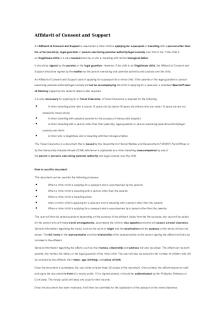SPD-310-T2-RS-Philosophy of Inclusion Research Support Template PDF

| Title | SPD-310-T2-RS-Philosophy of Inclusion Research Support Template |
|---|---|
| Course | Collaborations and Communications in Special Education |
| Institution | Grand Canyon University |
| Pages | 4 |
| File Size | 235.5 KB |
| File Type | |
| Total Downloads | 63 |
| Total Views | 151 |
Summary
Philosophy of inclusion assignment...
Description
Philosophy of Inclusion Research Support Template Part 1: Journal Article Reviews Research three scholarly articles about the benefits of including students with disabilities in general education classrooms. Article 1 Title: The Benefits of Inclusion Summary This article is about the importance of inclusion. It advocates for (Summarize how the inclusion in the classroom and shares that children learn from each other. Students with special needs, general education students, article supports a philosophy of parents, and teachers learn so much from inclusion. It also inclusion.) explains why the involvement of the parents is essential for inclusion. Common Argument One argument would be the attitudes and beliefs of the parties (Describe a common involved. Sometimes parents or general education teachers do not claim, not in favor want try inclusion because it is too much work or too risky. They of inclusion, that are unwilling to embrace the philosophy of inclusion and change their existing practices. (Villegas, 2015). this article could counter argue.) I will group up my students more often. Students can learn more Future Professional Practice Application from each other than they could learn from me. Sometimes peers (Explain how you their age explain it better than the teacher can. In my future could apply this classroom, I will incorporate more group activities and have them information to your learn in groups to help them grow. own future professional practice.) Aguilar, E., (n.d.). The Benefits of Inclusion. Retrieved from Reference (Article citation) https://www.easterseals.com/blakefoundation/sharedcomponents/document-library/the-benefits-of-inclusion.pdf Article 2 Title: 4 Benefits of Inclusive Classrooms Summary This article shares 4 benefits of inclusive classroom. Inclusion (Summarize how the tailors teaching for all students, it makes differences less different, article supports a it provides support to all students, and creates high expectations philosophy of for everyone. It breaks down each one and advocates for inclusion inclusion.) benefiting everyone not just students with special needs. Common Argument One argument is the curriculum requirements. Some districts or (Describe a common schools allow very limited wiggle room to teach students with disabilities. They force teachers to teach the objective a certain way claim, not in favor of inclusion, that without any outside resources or tools. (Villegas, 2015). this article could © 2019. Grand Canyon University. All Rights Reserved.
counter argue.) Future Professional Practice Application (Explain how you could apply this information to your own future professional practice.) Reference (Article citation)
In my future classroom, I will allow speech therapists and special service workers to come into my classroom to aid the students. This is beneficial to other students who may be struggling, but do not have an IEP, as well. It makes different learning styles more prominent and people not ashamed of struggling in school.
Understood Team, (n.d.). 4 Benefits of Inclusive Classrooms. Retrieved from https://www.understood.org/articles/en/4-benefitsof-inclusive-classrooms Article 3 Title: Inclusive Education and it’s Benefits Summary This article lists the benefits of inclusion and highlights how it is (Summarize how the beneficial for all. It also shares that teachers must learn how to be article supports a creative and make the classroom a place where all children can philosophy of participate. Teachers must learn to teach in different ways and to design our lessons so that every student can be involved. inclusion.) Common Argument (Describe a common claim, not in favor of inclusion, that this article could counter argue.) Future Professional Practice Application (Explain how you could apply this information to your own future professional practice.) Reference (Article citation)
One argument would be instructional practices, which is the lack of understanding general education practices and how students with disabilities can participate in general education instruction while providing specialized instructions in unique education goals. (Villegas, 2015). Basically, teachers not knowing how to create lessons that include everyone’s different needs, especially regarding students with disabilities. In my future classroom, I will create lessons that apply to every student and that all students can participate in. From there I can add complexity for other students and allow them to add to their learning if they need it. This allows me to include everyone, while still teaching complex objectives to the students who are advanced.
New Brunswick Association for Community Living, (n.d.). Inclusive Education and it’s Benefits. Retrieved from https://nbacl.nb.ca/module-pages/inclusive-education-and-itsbenefits/
Part 2: Philosophy of Inclusion In 250 words or less, compose your own philosophy of inclusion describing how inclusion supports creating a safe, inclusive, positive learning environment to engage and promote the well-being of individuals with disabilities. Use the articles reviewed in Part 1 of this assignment to support your philosophy.
© 2019. Grand Canyon University. All Rights Reserved.
Inclusion is beneficial to everyone, not just students with special needs. Erin Aguilar (n.d.) shares, “With inclusion in place, children with special needs are provided equal opportunity to participate in the same types of programs and activities as children without special needs. Some of the benefits of inclusion for children with (or without) disabilities are friendship skills, peer models, problem solving skills, positive self-image, and respect for others” (p.1). Including students with special needs allows others to learn respect for others. It creates a positive environment where students can feel confident and included. They can make friendships and socialize with their peers. Inclusion also makes diversity less different. (Understood Team, n.d.) It promotes different learning styles and allows students to learn from each other. Every student is different and needs different things to help them learn better. Everyone can see these needs and understand that diversity is good. Inclusion also teaches teachers how to create lessons that actively involve and include every student, no matter the differences. (NBACL, n.d.). Teachers learn different ways to include every student and allow them to participate, even with their current disabilities at hand. All students are able to participate and learn in their own way while also being a part of a positive community at school. Inclusion is a very important concept that all teachers should be incorporating in their classrooms.
Part 3: Communicating Your Philosophy In 250-500 words, describe how you might effectively communicate your philosophy of inclusion to a school leader to build positivity toward inclusion and promote the well-being of students with disabilities. Address how you would persuade a colleague who does not believe in inclusion to share your philosophy. Support both positions using at least one of the articles reviewed in Part 1. Have you ever felt unincluded in a game or activity at school? How did you feel? I have felt unincluded at school and it was not a fun experience. I felt alone and not good enough to be anyone’s friend. I felt like a loser and unimportant to anyone at all. That is how a student with special needs feels when they are not included with peers their age. Their confidence and selfimage go down and they do not feel important. Inclusion not only builds their confidence and self-image, but it also boosts their learning motivation. Research shows that students who are included are absent less often and develop stronger skills in reading and math (Understood Team, n.d.). They have a successful future and strive to pursue careers after high school. It creates a positive environment for all students not just ones with disabilities. Every student learns how to create friendships and deal with diversity. They learn how to help others different than them and learn from each other. Teachers learn how to create lesson plans for everyone and teach to diversity not accommodating for it. Inclusion helps everyone! I know inclusion is hard to accomplish correctly due to the lack of resources like funding, time, materials, equipment, or technology (Villegas, 2015), but it is essential for student with special needs to thrive and learn better. It can be difficult to include students with special needs because © 2019. Grand Canyon University. All Rights Reserved.
of the unknowns and barriers that come up due to their disabilities. It is hard to change the normal routine of things and create different lesson plans keeping their struggles in mind, but it makes or breaks the education for the student. We are teachers who build students up and grow them to their fullest potential, so why can’t we do the same for students with disabilities? It will be difficult, but it is essential for them to learn. It boosts their confidence and allows them to socialize with their peers. It makes them enjoy school more and make them want to learn. It also allows other students to learn how to respect and help each other, despite the differences. Inclusion is not just for the student with disabilities, it is for everyone. Wouldn’t you want to be included in your classroom even if you had struggles with learning? Give these students a chance and allow them to be loved and cared on by you.
References Aguilar, E., (n.d.). The Benefits of Inclusion. Retrieved from https://www.easterseals.com/blakefoundation/shared-components/document-library/the-benefitsof-inclusion.pdf New Brunswick Association for Community Living, (n.d.). Inclusive Education and it’s Benefits. Retrieved from https://nbacl.nb.ca/module-pages/inclusive-education-and-its-benefits/ Understood Team, (n.d.). 4 Benefits of Inclusive Classrooms. Retrieved from https://www.understood.org/articles/en/4-benefits-of-inclusive-classrooms Villegas, T., (2015, September 14). The Biggest Barriers to Inclusive Education. Retrieved from https://www.thinkinclusive.us/post/barriers-to-inclusive-education
© 2019. Grand Canyon University. All Rights Reserved....
Similar Free PDFs

Index of inclusion
- 106 Pages

Research Report Template pdf
- 3 Pages

Research proposal template APA
- 8 Pages

Research proposal template APA
- 8 Pages

IPP Legal Research Template
- 2 Pages

QUALITATIVE RESEARCH TEMPLATE 1
- 1 Pages

Affidavit of support
- 3 Pages

Inclusion notes
- 10 Pages

Affidavit of Consent and Support
- 2 Pages
Popular Institutions
- Tinajero National High School - Annex
- Politeknik Caltex Riau
- Yokohama City University
- SGT University
- University of Al-Qadisiyah
- Divine Word College of Vigan
- Techniek College Rotterdam
- Universidade de Santiago
- Universiti Teknologi MARA Cawangan Johor Kampus Pasir Gudang
- Poltekkes Kemenkes Yogyakarta
- Baguio City National High School
- Colegio san marcos
- preparatoria uno
- Centro de Bachillerato Tecnológico Industrial y de Servicios No. 107
- Dalian Maritime University
- Quang Trung Secondary School
- Colegio Tecnológico en Informática
- Corporación Regional de Educación Superior
- Grupo CEDVA
- Dar Al Uloom University
- Centro de Estudios Preuniversitarios de la Universidad Nacional de Ingeniería
- 上智大学
- Aakash International School, Nuna Majara
- San Felipe Neri Catholic School
- Kang Chiao International School - New Taipei City
- Misamis Occidental National High School
- Institución Educativa Escuela Normal Juan Ladrilleros
- Kolehiyo ng Pantukan
- Batanes State College
- Instituto Continental
- Sekolah Menengah Kejuruan Kesehatan Kaltara (Tarakan)
- Colegio de La Inmaculada Concepcion - Cebu






